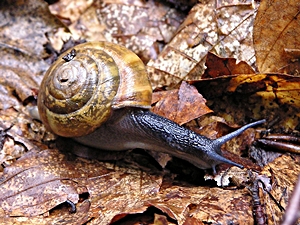
Aegopis verticillus on Wilhelminenberg hill in Vienna. [RN]
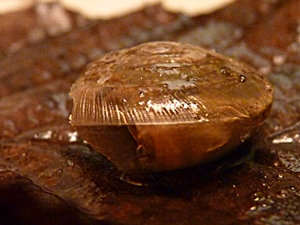
The distinct keel of a juvenile Aegopis.
Picture: Martina Eleveld.
Aegopis verticillus Lamarck 1822
 Aegopis verticillus on Wilhelminenberg hill in Vienna. [RN] |
|
 The distinct keel of a juvenile Aegopis. Picture: Martina Eleveld. |
Class:
Gastropoda
![]() Subclass:
Pulmonata
Subclass:
Pulmonata
![]() Superorder:
Eupulmonata
Superorder:
Eupulmonata
![]() Order:
Stylommatophora
Order:
Stylommatophora
![]() Suborder:
Sigmurethra
Suborder:
Sigmurethra
![]() Infraorder:
Arionoinei
Infraorder:
Arionoinei
![]() Superfamily:
Zonitoidea
Superfamily:
Zonitoidea
![]() Family:
Zonitidae Mörch 1864
Family:
Zonitidae Mörch 1864
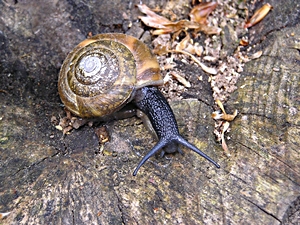 Well visible: The alternating light stripes on the shell of Aego- pis verticillus. [RN] |
|
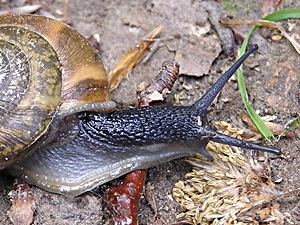 A view of an Aegopis verticillus' head with the long tentacles. [RN] |
![]() Source:
Mollbase on
http://www.mollbase.de/list/ and Fauna Europaea on
http://www.faunaeur.org.
Source:
Mollbase on
http://www.mollbase.de/list/ and Fauna Europaea on
http://www.faunaeur.org.
Aegopis verticillus is a large kind of true glass snail characteristic for the Vienna woods hill country west and south-west of Vienna, where the large snails with the glossy shell can be found in humid places in the forest. This snail species' shell is roundish and conical with an elevated spire.
While the outermost whorl in adult shells displays a blunt keel, there is a sharp one in juvenile shells, so those have been confounded in their fossil state with shells of the lapidary snail (Helicigona lapicida).
The glossy horn coloured shell of Aegopis verticillus has a grid-like surface structure from criss-crossing longitudinal and transversal stripes. Transversally to the whorls, lighter coloured zones can be seen, marking previous pauses in shell growth (winter, aestivation in summer). Those yellowish zones are characteristic for Aegopis verticillus and can be seen in a similar way in the Illyrian rock snail (Faustina illyrica).
Dimensions: Height: 16 - 17 mm; Width: 26 - 30 mm; Whorls: ca. 6.
The snail itself is slender with a narrow foot sole. It has a light to dark grey colour, some almost black, with a musty yellowish hue at the flanks. The tentacles are very long.
Like most true glass snails (Zonitidae), Aegopis verticillus also is at least an omnivore. It feeds on dead plant matter, but also on carrion and smaller snails, but especially their eggs.
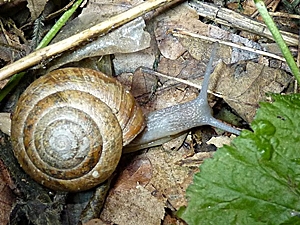 A light grey specimen of Aegopis verticillus from Lower Austria, south of Vienna. Picture: Martina Eleveld. |
Aegopis verticillus in its deciduous forest habitat can be found under fallen leaves and between stones on humid ground, as well as where a stream disappears in the ground. Usually the species is found in hillside and mountain areas in lower altitudes. Dry periods the snail waits out dug into loose earth.
The species' distribution area stretches from Bosnia, Montenegro and Hungary
to the eastern Alps, the Carinthian and East Tyrolean Alps and the Salzburg
Alps. In a disperse manner, the species appears as far as the Moravian hill
country. In Italy, the species is distributed in the south in Calabria. There
are single German populations, for example near Marktschellenberg in the
Berchtesgaden country, in the Salzach valley and in the southern Bavarian woods.
In 1880, Aegopis verticillus was introduced by man in Landberg on Lech. In
Germany, the species is classified as vulnerable (VU) (see also:
![]() IUCN Threat Categories).
IUCN Threat Categories).
![]() Wikipedia:
Die
Wirtelschnecke (Aegopis verticillus), started by the author. (In
German)
Wikipedia:
Die
Wirtelschnecke (Aegopis verticillus), started by the author. (In
German)
![]() Francisco Welter-Schultes:
Aegopis verticillus species homepage.
Francisco Welter-Schultes:
Aegopis verticillus species homepage.